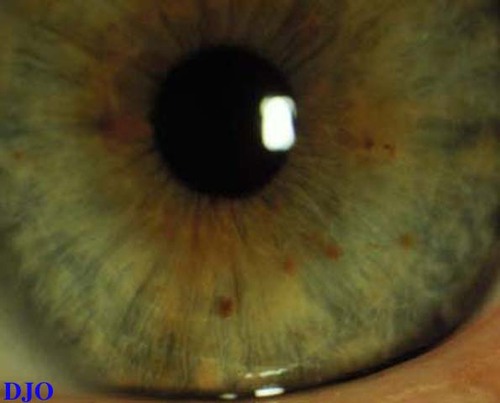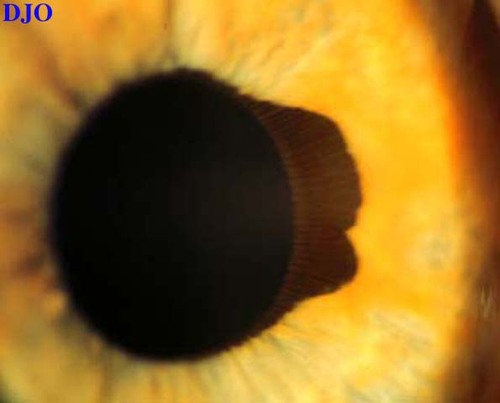General Ophthalmology Quiz 4

Figure 1
Figures 1-2. Left and right eyes of a 25 year old woman. The apparent heterochromia is an artifact of the photography and lighting.
Figures 1-2. Left and right eyes of a 25 year old woman. The apparent heterochromia is an artifact of the photography and lighting.

Figure 2
Answer: The photographs demonstrate Lisch nodules and ectropion uvea in this patient who had a diagnosis of neurofibromatosis.
2. What is the prevalence, inheritance pattern, and chromosomal location of this condition?
Answer: NF-1 is one of the more common genetic disorders in humans with a prevalence of 1in 3000. The gene, located on chromosome 17, is inherited autosomal dominantly and spontaneous new mutations are common.
3. What are the cutaneous manifestations of this disease?
Answer: The classic cutaneous triad in NF-1 is café-au-lait spots, fibroma molluscum, and plexiform neurofibromas, in addition axillary and inguinal freckling is common.
4. What are the ocular manifestations of this disorder?
Answer: Lisch nodules (iris hamartomas) are the most common ocular manifestation of NF-1,and are present in more than 92% of patients over 5 years of age. The cutaneous manifestations mentioned above may occur on the lids. A plexiform neurofibroma of the upper lid may appear as a thickened area of the lid margin and may have the characteristic S-shaped lid deformity. Patients with plexiform neurofibroma on the lid may also have ipsilateral congenital glaucoma with or without buphthalmos and ectropion uvea. Patients may also have conjunctival hamartomas and prominent corneal nerves. Retinal astrocytic hamartomas, and choroidal hamartomas may also be seen in NF-1.
5. What other findings might be present? (CNS , skeletal, visceral?)
Answer: NF-1 patients may develop spinal cord and nerve root neurofibromas, as well as intracranial or spinal cord gliomas, and meningiomas which may lead to neurologic deficits. Characteristic skeletal manifestations of NF-1 include sphenoid dysplasia, progressive kyphoscoliosis, and non-healing fractures. Visceral involvement may include gastrointestinal hamartomas, and NF-1 patients have an increased incidence of pheochromocytoma.
6. What criteria are sufficient to make the diagnosis?
Answer: A diagnosis of NF-1 requires 2 or more of the following signs:
- 6 or more café-au-lait spots (larger than 5mm before puberty or 15mm after puberty)
- 2 neurofibromas of any type or 1 plexiform neurofibroma
- Axillary or inguinal freckling
- Optic pathway glioma
- 2 or more Lisch nodules
- A characteristic osseous lesion
- A first degree relative with NF-1